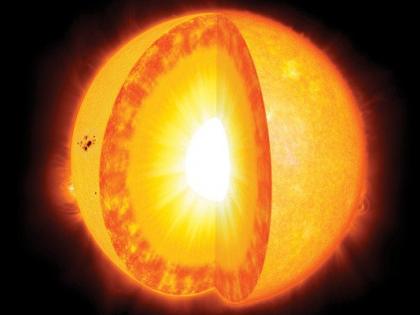IIA Astronomers’ New Study Shows How the Sun Rotates at Various Speeds From Its Equator to Its Poles and Faster Rotation at Its Equator
By Anubha Jain | Updated: September 27, 2024 17:24 IST2024-09-27T17:24:13+5:302024-09-27T17:24:50+5:30
The Indian Institute of Astrophysics (IIA) from the Kodaikanal Solar Observatory has made a groundbreaking discovery about the Sun’s ...

IIA Astronomers’ New Study Shows How the Sun Rotates at Various Speeds From Its Equator to Its Poles and Faster Rotation at Its Equator
The Indian Institute of Astrophysics (IIA) from the Kodaikanal Solar Observatory has made a groundbreaking discovery about the Sun’s rotation. This detailed new study or finding will help astronomers a better understanding of solar activity and its potential impact on Earth. The astronomers have mapped how the Sun’s outer layer called the Chromosphere rotates at various speeds from its equator to its poles.The research, published in the Astrophysical Journal, can help give a complete picture of the Sun’s inner workings.
They have found out that the Sun rotates faster at its Equator only about 25 days to complete a rotation, whereas, the poles take 35 days. This varied rotation speed is called differential rotation. The scientists have discovered that the Sun’s equator rotates at about 14 degrees per day while areas near the poles rotate at only 10.5 degree per day. Earth spins like a rigid ball, completing a full rotation every 24 hours. But the Sun, being a giant ball of plasma, has different parts that rotate at varied speeds. The finding of differential rotation dates back to Richard Carrington in the 19th century who found that sunspots on the visible surface of the sun rotate at different speeds depending on their latitude. The Department of Science and Technology (DST) claimed that sunspots don’t appear at latitudes higher than about 35 degree north or South of the solar equator, and other methods had to be used to measure differential rotation closer to the polar latitudes.
Unlike sunspots, plages are brighter regions with weaker magnetic fields. They reside in the chromosphere and are significantly larger than sunspots, ranging from 3 to 10 times the size of sunspots. Network features, on the other hand, are embedded with weaker magnetic fields and are about 30,000 km across. They are slightly larger than individual sunspots but smaller than sunspot groups. Both plages and networks are continuously present across the Sun’s surface throughout the solar cycle. By analyzing data from the Observatory, the team extracted the rotation period of these features at various latitudes. IIA’s Muthu Priyal, a co-author of the new study said, “We hit on the idea of using solar plages (bright regions in the Sun’s chromosphere) and network cells to measure rotation speed.”